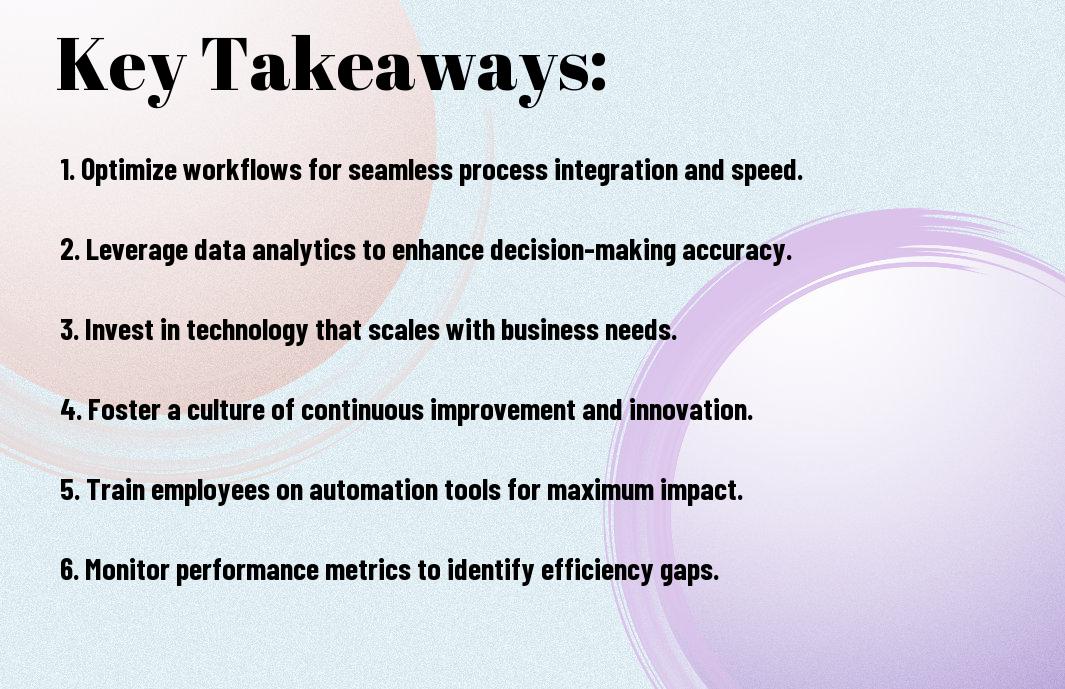Automation in business has become an vital mechanism for enhancing productivity and minimizing overhead costs. By understanding what drives remarkable efficiency in automation, you can strategically align your processes and technology to achieve optimal results. From streamlining workflows to integrating advanced software tools, each element plays a significant role in elevating your business performance. This exploration dives into the key factors that influence effective automation, equipping you with the insights needed to maximize your operational capabilities.

Key Takeaways:
- Streamlined processes are necessary for minimizing waste and maximizing productivity in automated systems.
- Integration of advanced technologies, such as AI and machine learning, enhances decision-making and operational agility.
- Regular training and upskilling of employees are vital to ensure effective usage and management of automation tools.
- Data-driven insights help identify bottlenecks and inform continuous improvement strategies in automated workflows.
- Collaboration between departments fosters innovation and optimizes the implementation of automated solutions across the business.

Understanding Automation
For businesses today, understanding automation is key to driving operational efficiency and maximizing productivity. Automation refers to using technology to perform tasks with minimal human intervention. By implementing effective automation strategies, you can streamline processes and reduce costs. To dive deeper into this topic, check out this insightful resource on Business Efficiency Automation Drives Corporate Growth.
Definition of Automation
To define automation, it is the use of systems and technology to carry out tasks automatically, resulting in improved efficiency and accuracy. This process eliminates repetitive manual tasks, freeing up your resources for more value-added activities.
Types of Automation in Business
At the core of business operations, several types of automation exist. These can be categorized as follows:
| Type of Automation | Description |
| Fixed or Hard Automation | Involves specialized equipment for a specific set of tasks. |
| Programmable Automation | Allows reprogramming of equipment for different tasks or products. |
| Flexible or Soft Automation | Can easily adapt to changes in the production process. |
| Industrial Automation | Focuses on machinery and systems to control industrial operations. |
| Office Automation | Encompasses computer software to carry out administrative tasks. |
This understanding helps you pinpoint which type best fits your operational needs.
Automation involves various subcategories, each uniquely tailored to improve your business processes. By leveraging different automation types, you can enhance productivity and reduce operational costs. These may include:
- Robotic Process Automation (RPA)
- Business Process Automation (BPA)
- IT Process Automation (ITPA)
- Test Automation
- Marketing Automation
This targeted approach ensures efficient task management in different business areas.
| Automation Type | Benefits |
| Robotic Process Automation | Conducts high-volume tasks tightly. |
| Business Process Automation | Streamlines end-to-end process flows. |
| IT Process Automation | Enhances security and reliability of IT operations. |
| Test Automation | Increases testing efficiency and coverage. |
| Marketing Automation | Improves customer engagement and tracking. |
By identifying suitable automation types, you can significantly amplify your business’s efficiency and growth performance.
Key Drivers of Efficiency
It is vital to understand that efficiency in automation is driven by several key factors. These drivers shape how your business can optimize operations, enhance productivity, and ultimately reduce costs. By focusing on these areas, you can unlock the full potential of automation and streamline your processes for better outcomes.
Technology Advancements
Around the globe, technology continues to evolve rapidly, offering tools and solutions that can significantly enhance your business operations. By staying informed about the latest advancements in automation technology, you can effectively leverage these innovations to improve efficiency and productivity in your daily tasks.
Process Optimization
Behind every efficient automation strategy lies a well-optimized process. Identifying and refining workflows can lead to remarkable gains in performance, allowing you to eliminate redundancies and focus on value-added activities.
Due to the dynamic nature of business environments, process optimization becomes a continual journey rather than a one-time effort. By regularly analyzing and adjusting your processes, you can maintain high levels of efficiency and adapt to changing market conditions. Incorporating feedback loops, performance metrics, and employee insights can further enhance your optimization efforts, ensuring your automation initiatives yield sustainable results over the long term.

Impact of Data Analytics
Not all automation is created equal; the impact of data analytics is undeniable. By harnessing data insights, you can streamline processes, reduce costs, and improve decision-making. With effective data analytics, your business can identify patterns, track performance, and uncover opportunities that may have previously gone unnoticed. Integrating these insights leads to increased efficiency and creates a more agile business environment.
Role of Big Data
Behind every successful automation initiative lies the power of big data. This vast repository of structured and unstructured information allows you to drive intelligent insights that inform your business processes. By leveraging big data, you can identify trends, anticipate challenges, and enhance customer experiences, giving you a competitive edge in today’s market.
Predictive Analytics in Automation
On the frontier of data analytics, predictive analytics is reshaping the landscape of business automation. By analyzing historical data, you can forecast future trends, enabling you to make informed decisions that enhance operational efficiency and minimize risks.
Indeed, predictive analytics plays a transformative role in automation by allowing you to preemptively address potential issues and tailor strategies that maximize performance. By analyzing vast amounts of data, you can identify trends and patterns that inform your decisions, enabling you to pivot proactively instead of reactively. This proactive approach leads to optimized processes and more efficient operations, as your business can anticipate changes rather than merely responding to them. Ultimately, predictive analytics empowers you to build a smarter, more agile organization that thrives on efficiency and innovation.
Human Factors in Automation
All businesses must consider the human elements that influence the success of automation initiatives. Understanding how employees interact with technology can significantly enhance operational effectiveness. Key factors include:
- Employee engagement
- Communication styles
- Collaboration practices
- Employee feedback mechanisms
Any automation strategy that neglects these human factors risks facing employee resistance and suboptimal results.
Employee Training and Adaptation
Factors such as adequate training and adaptability play a vital role in the effectiveness of automation. Providing comprehensive education enables employees to harness the full potential of new technologies, resulting in smoother transitions and increased productivity.
Leadership and Change Management
At the heart of successful automation lies effective leadership and change management. Your leaders must communicate a clear vision and provide support throughout the transformation process to ensure that your teams feel valued and involved.
And active leadership fosters an environment where change is welcomed rather than feared. Engage your team with open forums, seek their input, and champion their contributions. This approach not only eases the transition but also promotes a culture of continuous improvement, ultimately driving greater efficiency and effectiveness in your automation strategies.
Case Studies of Successful Automation
Now, let’s explore notable case studies that illustrate the effectiveness of automation across different industries:
- Amazon: Reduced processing times by 75% through automated fulfillment centers, increasing operational efficiency.
- Siemens: Achieved a 30% reduction in production costs due to robotic assembly lines, enhancing output quality.
- Netflix: Utilized algorithm-driven content recommendations, raising viewer engagement by 80%.
- Unilever: Streamlined supply chain management, realizing a 20% savings in logistics expenses.
For more insights, check out 15 Statistics That Show How Automation is Boosting …
Manufacturing Sector
Before stepping into automation, you should know that the manufacturing sector has significantly benefited from technology advancements. Integrating robotic process automation has led to increased precision and reduced errors in various production phases, creating a leaner manufacturing process and elevating overall productivity.
Service Industry
Manufacturing firms aren’t the only ones reaping the rewards of automation; the service industry is also experiencing substantial enhancements in efficiency. By employing chatbot technology and automated customer service platforms, organizations have improved response times and customer satisfaction rates by up to 40%.
To expand on this, automation in the service industry has streamlined routine tasks, allowing employees to focus on more strategic initiatives. Companies can optimize workflows by adopting tools that manage data entry and appointment scheduling, which ultimately results in improved client experiences and significant cost reductions. This shift not only enhances productivity but also fosters a more agile business model, better equipped to respond to market demands.
Challenges and Risks
Many businesses encounter significant challenges and risks when adopting automation. While innovations like Process Automation: Unlocking Efficiency And Innovation offer potential gains, they also introduce complexities in execution and management that must be navigated carefully.
Implementation Hurdles
Any automation initiative can face obstacles during implementation, including employee resistance, insufficient training, and compatibility issues with existing systems. To overcome these hurdles, it’s crucial to foster a culture of adaptability and provide adequate resources for your team.
Data Security Concerns
With the rise of automation comes an increased focus on data security. Automated processes can expose your business to risks, including unauthorized access and data breaches, which could compromise sensitive information.
Consequently, to protect your business, it’s crucial to implement robust security measures, including encryption, regular security audits, and strict access controls. Additionally, invest in training programs that educate your team on best practices for data safeguarding to ensure a more secure automated environment.
Summing up
Hence, understanding what drives remarkable efficiency in automation in your business requires a focus on integrating advanced technologies, streamlining processes, and fostering a culture of continuous improvement. By leveraging data analytics, employing intelligent automation tools, and ensuring employee engagement, you can significantly enhance productivity and reduce operational costs. Staying adaptable to change and embracing innovation will empower your organization to thrive in a competitive landscape and maximize the benefits of automation.
FAQ
Q: What are the key factors that contribute to efficiency in business automation?
A: Several factors can enhance efficiency in business automation, including the integration of advanced technologies like AI and machine learning, streamlined workflows that minimize bottlenecks, and clear communication channels among teams. Furthermore, investing in employee training ensures that personnel are adept at using automated tools effectively.
Q: How can businesses identify tasks suitable for automation?
A: Businesses can identify tasks for automation by evaluating repetitive and time-consuming processes that do not require complex decision-making. Conducting a task analysis may highlight areas where automation can simplify operations, reduce errors, and free up employee time for more strategic work.
Q: What role does data play in driving efficiency in automation?
A: Data plays a significant role in enhancing automation efficiency. By analyzing historical data, businesses can pinpoint trends and patterns that guide decision-making. Accurate data also allows for better automation configurations, enabling systems to adapt and optimize operations in real-time.
Q: How can employee feedback enhance automation processes?
A: Employee feedback is valuable for refining automation processes. Gathering insights from users about their experiences with automated tools can uncover gaps, inefficiencies, and areas for improvement. This iterative feedback loop helps businesses to continually adapt and enhance their automation strategies to better meet user needs.
Q: In what ways can automation create a competitive advantage for businesses?
A: Automation can provide a competitive advantage by speeding up processes, reducing operational costs, and increasing output quality. Businesses that successfully implement automation can respond more rapidly to market demands, enhance customer service, and innovate more effectively than those relying solely on manual processes.
Q: What challenges might businesses face when implementing automation?
A: Some challenges include resistance to change from employees, integration issues with existing systems, and the necessity for ongoing maintenance and updates to automated tools. Additionally, ensuring data security and compliance with regulations is vital during the automation implementation process.
Q: How can businesses measure the success of their automation initiatives?
A: The success of automation initiatives can be measured using key performance indicators (KPIs) such as time savings, cost reductions, error rates, and employee productivity levels. Developing specific metrics prior to implementation enables businesses to track performance and make data-driven adjustments to their automation strategies over time.



